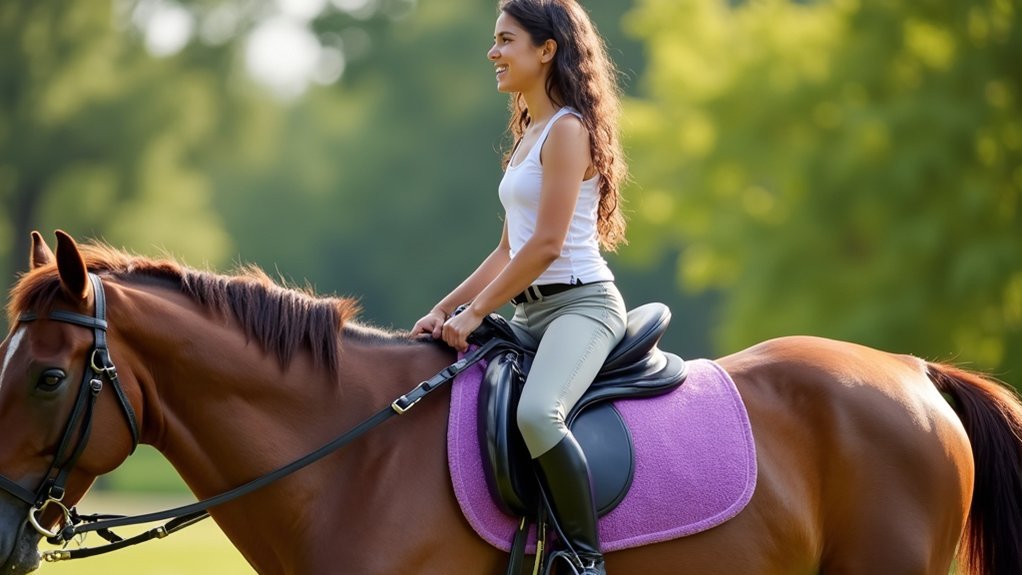Therapeutic riding programs use several balance aids to support your success. These include adaptive saddles with high backs and deeper rolls, specialized reins with color-coding and grip options, and safety stirrups with release mechanisms. Supportive tools like grab straps, balance pads, and body positioning devices help maintain proper alignment while building core strength. As you progress, therapists gradually reduce these supports to encourage independence, following personalized assessment plans. These essential tools create a foundation for achieving therapeutic benefits.
What Balance Aids Help Horse Therapy Riders?

When riders with disabilities participate in equine therapy, specialized balance aids become essential tools for their success and safety. These supports are tailored to each rider’s unique needs, enhancing their therapeutic experience while building confidence.
High-back saddles provide vital stability by supporting proper posture during therapy sessions. For developing riders, adaptive equipment like bareback pads and saddles with handles offer the security needed to focus on balance development rather than fear of falling.
Rainbow reins serve dual purposes – providing guidance while encouraging independence in movement and coordination.
Before mounting, groundwork activities introduce riders to their horse partners, establishing comfort and preliminary balance skills in a controlled environment. Together, these balance aids create a supportive foundation for therapeutic riding progress.
Understanding the Role of Balance in Therapeutic Riding
Although riders face numerous challenges during equine therapy, balance remains the cornerstone skill that supports all other therapeutic benefits. When you’re seated on a horse, your body must constantly adjust to the animal’s movements, engaging your core muscles and developing proprioception.
Balance aids serve as critical tools that allow you to focus on therapeutic goals rather than struggling to stay mounted. With proper support, you’ll experience improved posture and alignment, which enhances your interaction with the horse.
Proper balance support frees riders to embrace the full therapeutic potential of equine connection rather than fearing a fall.
These aids don’t just prevent falls; they actively contribute to developing your motor skills and coordination.
As you progress in your therapeutic riding journey, balance aids help transform what might be an anxiety-producing activity into an opportunity for physical, emotional, and social growth.
Adaptive Saddles and Their Stabilizing Features

Adaptive saddles offer you specialized security features like high backs and deeper thigh rolls that prevent slipping during therapeutic riding sessions.
You’ll find that these saddles include customized padding and adjustable components designed to support your unique postural needs while mounted.
The thoughtful design elements, including handles and quick-release stirrups, will enhance your stability and confidence as you connect with your therapy horse.
Saddle Security Features
The specialized design of therapeutic saddles provides critical support for riders with balance challenges during equine therapy.
These saddles incorporate security features that help you maintain proper positioning while building confidence during rides.
When selecting an adaptive saddle, you’ll benefit from these key security elements:
- High-back support structures that cradle your torso, preventing backward tipping and enhancing your stability during movement.
- Reinforced side panels with strategically placed handle grips that offer immediate support when you need to regain balance.
- Pressure-distributing designs that not only keep your horse comfortable but also create a more stable base for your riding position.
Many saddles also include adjustable stirrups that accommodate your unique physical needs, ensuring you’ll maintain secure contact throughout your therapy session.
Customized Postural Support
Beyond basic saddle security, properly designed adaptive saddles offer tailored postural support that addresses your specific physical needs during equine therapy.
You’ll find high-back designs and strategically placed thigh blocks that stabilize your position and promote proper alignment throughout your session.
These specialized saddles feature adjustable components that can be customized to your unique requirements, enhancing both comfort and security during rides.
The special padding distributes pressure evenly across contact points, reducing discomfort and allowing you to focus on therapeutic benefits rather than physical strain.
With customized postural support, you’ll experience improved balance and stability on horseback.
Research shows riders using adaptive saddles demonstrate greater confidence and achieve better therapeutic outcomes, including enhanced coordination and increased muscle strength—all critical benefits that maximize your equine therapy experience.
Specialized Reins for Enhanced Control and Stability
Specialized reins like rainbow reins offer you color-coded guidance that simplifies hand placement and enhances your communication with the therapy horse.
You’ll find adapted grip options, such as the Harry Dabbs dragonfly reins, particularly helpful for maintaining proper alignment and balance during your therapeutic riding sessions.
These customized rein systems can be matched to your specific needs, providing the right level of support while encouraging greater independence and confidence as you progress in your therapy.
Rainbow Reins for Guidance
Five distinct color zones on rainbow reins transform how therapy riders experience horseback riding control.
You’ll find these specialized therapeutic tools enhance your stability while maintaining proper posture and balance during rides. The color-coded system allows your instructor to clearly communicate rein pressure and position, making steering concepts more accessible.
Rainbow reins particularly benefit riders by:
- Promoting independent hand use that develops fine motor skills
- Providing a secure grip that reduces slipping, letting you focus on balance and coordination
- Adapting to your individual needs with a customizable approach that builds confidence
With rainbow reins, you’ll experience enhanced control while developing the essential skills needed for successful therapeutic riding outcomes.
Their thoughtful design supports your journey toward greater independence in the saddle.
Adapted Rein Grip Options
Innovative grip modifications offer therapy riders unprecedented control during equine sessions.
These adapted rein grip options feature ergonomic designs that reduce hand and wrist strain, allowing you to focus on maintaining proper posture and balance throughout your ride.
You’ll find rainbow reins with built-in handles or loops particularly helpful when maneuvering around obstacles or shifting between gaits.
These specialized reins adjust to accommodate your unique grip strength, ensuring secure communication with your horse while promoting confidence.
High-back saddles paired with customizable reins create a thorough support system tailored to your specific needs.
Your therapeutic riding instructor can modify these adapted rein grip options to match your progress, providing just enough assistance without limiting your independence.
This personalized approach maximizes the physical and emotional benefits of your equine therapy experience.
Stirrup Modifications That Support Therapeutic Goals

While standard stirrups serve typical riders adequately, therapeutic riding programs require specialized equipment to address unique physical and developmental needs. Stirrup modifications can dramatically improve your riding experience and therapeutic outcomes by enhancing stability, safety, and independence.
Adaptive stirrups transform therapeutic riding from challenging to accessible, empowering riders with diverse needs to experience equine connection safely.
- Safety stirrups with release mechanisms prevent your foot from becoming trapped during a fall, allowing you to focus on your riding experience rather than safety concerns.
- Non-slip stirrup pads provide essential grip for riders with coordination challenges, keeping your feet securely positioned throughout your session.
- Customized orthopedic stirrups with wider footbeds and adjustable lengths accommodate your specific physical needs, promoting proper alignment and supporting therapeutic goals.
Quick-release options also facilitate easier mounting and dismounting, building your confidence and independence during therapy sessions.
Safety Handles and Grab Straps for Rider Confidence
Safety handles and grab straps come in various designs from rigid handles to soft loops, each offering specific stability benefits based on your rider’s grip strength and needs.
You’ll want to position these aids strategically—forward on the saddle for riders needing trunk support, or centered for those working on balance refinement.
As your rider’s confidence grows, you can gradually reduce their reliance on these supports, moving from two-handed grips to single-hand holds and eventually to riding without additional balance aids.
Grip Types and Benefits
Secure grip options provide essential support for therapeutic riders, enabling them to focus on connection with their horse rather than worrying about falling.
When you’re selecting grip aids for therapeutic riding, consider how different styles support varying abilities and confidence levels.
Safety handles and grab straps come in several beneficial configurations:
- Fixed handles – Permanently attached to the front of the saddle, providing consistent support for riders with limited upper body strength.
- Removable straps – Adjustable options that can be modified as your riding skills improve, promoting gradual independence.
- Contoured grips – Ergonomically designed handles that reduce hand fatigue during longer sessions while encouraging proper wrist positioning.
These grip aids not only enhance your stability but also improve your posture and body alignment, creating more effective communication with your equine partner.
Positioning for Different Needs
Proper positioning of balance aids transforms a challenging ride into a therapeutic success for participants of all abilities.
When you’re setting up safety handles, consider the rider’s specific physical needs—front-mounted grips work best for those with core weakness, while side-positioned handles support riders with balance issues.
You’ll find that strategically placed grab straps allow riders to adjust their support level throughout the session.
For beginners or those with limited mobility, position handles within easy reach to build confidence before gradually moving them to encourage proper posture and core engagement.
Remember that the ideal placement encourages independence while ensuring security.
Building Independence Gradually
As riders grow more comfortable in the saddle, gradually reducing reliance on balance aids becomes a pivotal part of their therapeutic journey.
Safety handles and grab straps serve as interim tools that build confidence while developing essential riding skills. You’ll notice riders become less anxious and more engaged with their horse when they’ve secure gripping options.
The path to independence typically follows these stages:
- Full support – using safety handles for maximum stability during initial sessions
- Partial support – alternating between using handles and riding independently for short periods
- Minimal support – keeping grab straps available only when needed, building core strength and coordination
Balance Pads and Cushions for Postural Support
While mounted on a horse during therapy sessions, riders with physical limitations often benefit from specialized support equipment. Balance pads provide vital stability, helping you maintain proper positioning as your horse moves beneath you. These therapeutic aids encourage your core muscles to engage actively as you adjust to the horse’s shifting momentum.
You’ll find these cushions can be customized to your specific needs, with adjustable thickness and firmness levels that accommodate different physical abilities. Research shows that incorporating balance pads into your riding routine enhances body awareness and proprioception, giving you better control and coordination during therapy.
As you use these postural supports, you’ll likely experience improved confidence and comfort—essential components for making your therapeutic riding sessions both effective and enjoyable.
Body Positioning Tools and Their Therapeutic Applications
Body positioning tools represent foundational equipment in equine therapy, enabling riders with physical challenges to participate fully in therapeutic horseback experiences.
You’ll find these tools enhance stability while promoting independence and confidence during sessions. Adaptive saddles and high-back seats provide vital support for maintaining proper posture, allowing you to focus on the therapeutic benefits of riding.
Three essential body positioning tools include:
- Mounting platforms that offer accessible entry to horseback, reducing physical strain
- Rainbow reins that improve grip and control, enhancing your communication with the horse
- Specialized bareback pads that increase sensory awareness and strengthen core engagement
When combined with visual and tactile cues from instructors, these positioning aids create an all-encompassing therapeutic environment where you’ll develop balance, coordination, and a meaningful bond with your therapy horse.
Mounting Assists That Promote Independence
For riders participating in equine therapy, gaining independence begins with the mounting process. When you use mounting assists like platforms or ramps, you’re able to access horses safely while building self-confidence. These tools empower you to participate more fully in your therapeutic sessions.
| Mounting Assist | Benefits to Independence |
|---|---|
| Mounting platforms | Provides stable access at saddle height |
| High-back saddles | Offers additional trunk support during mounting |
| Safety stirrups | Prevents foot entrapment while mounting/dismounting |
| Rainbow reins | Provides stabilizing handholds during changeover |
| Groundwork activities | Builds confidence before attempting to mount |
Before using mounting assists, you’ll often engage in groundwork that develops balance and familiarity with your horse. This preparation, combined with appropriate adaptive equipment, creates a pathway to riding independence that builds both physical skills and personal autonomy.
Horse Selection Considerations for Balance-Focused Therapy
Selecting the right equine partner stands as perhaps the most essential decision in balance-focused therapy. Your therapeutic progress largely depends on finding a horse whose temperament, size, and movement patterns complement your specific balance needs.
The horse you choose becomes the foundation upon which your balance therapy builds its success.
When choosing the ideal therapy horse, consider:
- Temperament – Prioritize horses with calm, patient dispositions who remain steady when you’re working to find balance on their back.
- Movement quality – Seek horses with smooth, consistent gaits that naturally facilitate your balance development without jarring motions.
- Training level – Select horses experienced in therapeutic settings who respond predictably to subtle weight shifts and can compensate for your balance challenges.
Remember that a well-matched horse becomes an active partner in your therapy. Their rhythmic movement naturally encouraging your body to develop stronger balance responses.
Progression Planning: From Full Support to Minimal Assistance
While every therapeutic riding journey begins differently, successful balance development follows a carefully structured progression plan that gradually reduces physical support as your skills improve.
Your initial sessions will likely feature specialized adaptive equipment like high-back saddles and mounting platforms to maximize stability.
As you develop core strength and balance, your therapy team will introduce exercises promoting independent movement. You’ll gradually practice basic riding maneuvers with decreasing levels of physical assistance.
Throughout this process, regular assessments guarantee you’re receiving appropriate support that matches your evolving capabilities.
Effective progression planning prioritizes your confidence alongside physical skill development.
The ultimate goal is fostering your independence in the saddle, enabling you to participate in therapeutic riding with minimal assistance while maximizing physical and emotional benefits.
Frequently Asked Questions
How to Improve Balance for Horseback Riding?
Strengthen your core with seated marches and leg lifts. Practice on balance boards to improve proprioception. Use adaptive equipment like high-back saddles when needed. Regularly work on changes between gaits while riding.
How Do I Improve My Rider Balance?
You’ll improve your rider balance by engaging in groundwork activities, using adaptive equipment, practicing gait shifts, and riding circles or figures. Don’t forget to seek regular feedback from instructors on your body positioning.
What Are the 4 Natural Aids Used in Riding?
You’ll use four natural aids when riding: your seat (the most important), your legs for forward movement, your hands for direction through the reins, and your voice to reinforce commands.
What Are the 5 Rein Aids?
You’ll use five main rein aids when riding: direct rein to control forward movement, indirect rein for lateral guidance, opening rein for shoulder freedom, bearing rein against the neck, and pulley rein for emergency stops.
In Summary
You’ll find that the right combination of balance aids transforms therapeutic riding outcomes. Whether you’re using adaptive saddles, modified stirrups, or specialized reins, each tool serves an essential purpose in your rider’s journey. Remember, the goal isn’t permanent dependence but gradually reducing support as your rider develops strength and confidence. Choose aids that match your rider’s specific needs, and you’ll help access riding’s full therapeutic potential.





Leave a Reply